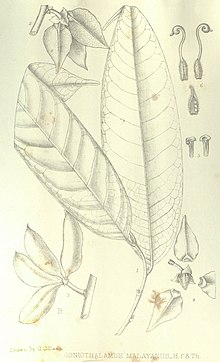Goniothalamus malayanus
Goniothalamus malayanus is a species of plant in the family Annonaceae. It is native to Borneo, the Malay Peninsula, the Nicobar Islands, Sumatra and Thailand.[2] Joseph Dalton Hooker and Thomas Thomson, the British botanists who first formally described the species, named it after part of its habitat range, British Malaya (now referred to as the Malay Peninsula).[3]
| Goniothalamus malayanus | |
|---|---|
 | |
| Botanical illustration of Goniothalamus malayanus.[1] | |
| Scientific classification | |
| Kingdom: | Plantae |
| Clade: | Tracheophytes |
| Clade: | Angiosperms |
| Clade: | Magnoliids |
| Order: | Magnoliales |
| Family: | Annonaceae |
| Genus: | Goniothalamus |
| Species: | G. malayanus |
| Binomial name | |
| Goniothalamus malayanus | |
| Synonyms | |
|
Goniothalamus dispermus Miq. | |
Description
It is a tree reaching 15 meters in height. Its bark is finely wrinkled and light colored with parts covered in greenish-brown hair. Its oval to elliptical leaves are 12.5-28 by 3.5-9 centimeters with tips that come to a tapering point and bases that pointed or rounded. The leaves are paper to leathery. The upper surface of the leaves are somewhat shiny and hairless or sparsely hairy, while the underside is hairless and pale. Its leaves have 10-18 pairs of secondary veins emanating from their midribs. Its slightly hairy to hairy petioles are 5-14 by 1.5-3.3 millimeters. Its flowering pedicels are 8-21 by 1-1.7 millimeters with dense yellow hairs. The pedicels are in axillary positions. Its green, oval to triangular sepals are 2-8 by 3-7.5 millimeters with margins that are fused at their base. The sepals come to a point at their tips. The inner surface of the sepals are densely hairy, while outer surface is hairless or slightly hairy. Its solitary flowers have 6 petals in two rows of three. The green-yellow, oval, outer petals are 1.6–6.2 × 0.7–3.2 centimeters. The inner surface of the outer petals are slightly to densely covered in small dark, silky hairs except near their base. The outer surface of the outer petals are densely hairy. The yellow to gold-colored inner petals are 0.77–1.4 × 0.4–0.75 centimeters and have a 1-2.6 millimeter wide claw at their base. The inner petals are densely hairy on their outer surfaces, but hairless on their inner surfaces. Its flowers have 80-250 stamen that are 1.3-2 by 0.3-0.6 millimeters. The connective tissue between the lobes of the anther terminates abruptly at its apex and is hairy. Its flowers have 8-20 carpels with ovaries that are 1-1.6 by 0.3-0.7 millimeters. The ovaries are covered in dense rows of hair. Together the hairless style and stigma are 1.6-4.2 by 0.1-0.2 millimeters. Its dark red, ellipsoid, slightly hairy to hairy fruit are 1.6-4.0 by 0.8-1.7 centimeters with smooth surfaces. The fruit are attached to the pedicels by 2.5-10 by 1.2-2.7 millimeter stipes. Its fruit have 1-3 smooth, flattened, ellipsoid seeds that are 1.3-2.0 by 0.55-1.3 centimeters. The seeds are sparsely hairy with patches of long white or gold-colored hairs.[4][3][5][6]
Reproductive biology
The pollen of G. malayanus is shed as permanent tetrads.[7]
Habitat and distribution
It has been observed growing in lowland forests and the drier parts of peat swamp forests at altitudes of 1-400 meters.[6][8][9]
Uses
Bioactive molecules extracted from its tissues have been reported to have antibacterial activity in tests with Gram positive and Gram negative bacteria.[10]
References
- King, George (1893). "Anonaceae of British India". Annals of the Royal Botanic Garden, Calcutta. 4: plate 128. Retrieved June 15, 2020.
- "Goniothalamus malayanus Hook.f. & Thomson". Plants of the World Online. The Trustees of the Royal Botanic Gardens, Kew. n.d. Retrieved January 23, 2019.
- Hooker, Joseph Dalton; Thomson, Thomas (1855). Flora Indica (in English and Latin). London: W. Pamplin. p. 107.
- Saunders, Richard M. K. (2002). "The genus Goniothalamus (Annonaceae) in Sumatra". Botanical Journal of the Linnean Society. 139 (3): 225–254. doi:10.1046/j.1095-8339.2002.00061.x. ISSN 1095-8339.
- King (1889). Materials for a flora of the Malayan Peninsula. no.1-5. Calcutta: Baptist Mission Press. p. 323.
- Saunders, Richard M. K. (2003). "A synopsis of Goniothalamus species (Annonaceae) in Peninsular Malaysia, with a description of a new species". Botanical Journal of the Linnean Society. 142 (3): 321–339. doi:10.1046/j.1095-8339.2003.00177.x. ISSN 1095-8339.
- Saunders, Richard M. K.; Chalermglin, Piya (2008). "A synopsis of Goniothalamus species (Annonaceae) in Thailand, with descriptions of three new species". Botanical Journal of the Linnean Society. 156 (3): 355–384. doi:10.1111/j.1095-8339.2007.00762.x. ISSN 0024-4074.
- Turner, I.M. (1947). "A Catalogue of the Vascular Plants of Malaya". The Gardens' bulletin, Singapore. 4. 47 (1): 114. Retrieved May 22, 2020.
- Corner, E.J.H. (1978). The Freshwater Swamp-forest of South Johore and Singapore. Singapore: Botanic Gardens, Parks & Recreation Dept. p. 97.
- Al Momani, Fouad; Alkofahi, Ahmad S.; Mhaidat, Nizar M. (2011). "Altholactone Displays Promising Antimicrobial Activity". Molecules. 16 (6): 4560–4566. CiteSeerX 10.1.1.361.1906. doi:10.3390/molecules16064560. ISSN 1420-3049.